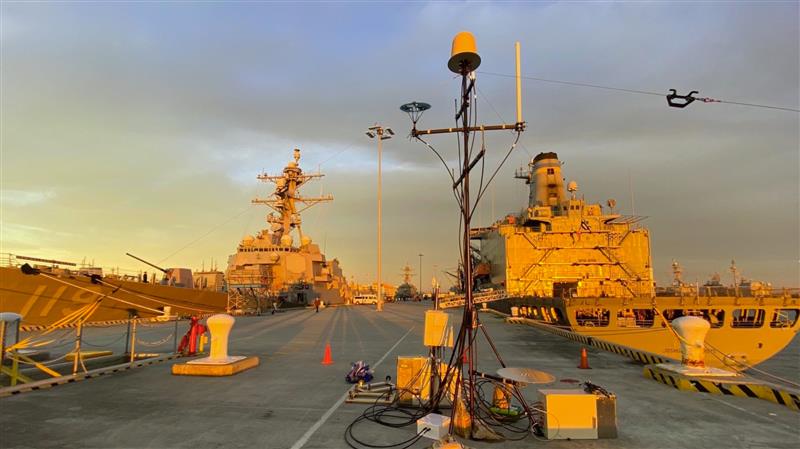Drone Defense at Sea: Countering the Rise of a Maritime Threat

CACI Maritime Technologies help detect, track, geolocate, and mitigate C-UxS threats at sea
Over a two-day period in late March 2024, Houthi rebels sent four one-way attack drones into the Red Sea. Their target: Nearby US Navy vessels.
The drones were successfully destroyed before they could cause harm, but the event was another reminder of how unmanned systems (UxS) are impacting Navy operations in the Red Sea and beyond. By the end of March, U.S. and coalition forces reported tracking the launch or intent to launch of 83 one-way attack drones by the Houthis: 72 in the air, 10 on the surface, and one underwater. In the same month, a group of Ukrainian drone operators used relatively inexpensive surface drones to disable a fifth Russian warship since the war began.
US Navy ships are at risk from UxS when operating in the Red Sea; moreover, a ship’s available defensive capabilities depend upon the situation. At sea, a ship can respond to an incoming drone more forcefully than while moving in or out of port as kinetic defensive weapon systems might be powered down or unsafe to use. “The Navy needs to have adequate protection capabilities that can be used in a number of situations, especially entering and exiting ports or while in tight transit zones” said Keith Denton, C-UxS Subject Matter Expert at CACI. “Our C-UxS solutions provide protection of forces, facilities, and assets, both moving and stationary.”
For the US Navy, staying a step ahead of rapidly evolving UxS threats is a high priority. Adversaries have ready access to inexpensive UxS technologies and—as with IEDs—they can quickly acquire, adapt, and employ them, requiring the US and its allies to continuously evolve solutions to defeat them. Companies like CACI, a defense technology company headquartered in Virginia, are partnering with the Navy to address the rising threat. CACI possesses a combination of Counter UxS expertise, operationally proven technologies, and the ability to innovate rapidly to keep pace with evolving threats.
CACI C-UxS capabilities: An interoperable systems approach
CACI is a leading provider of radio frequency (RF) based C-UxS solutions for the US Department of Defense and other federal agencies. “For two decades, CACI has analyzed unmanned systems, developed capabilities to detect and defeat them, and deployed more than 400 systems globally to protect our warfighters,” said Erik Grant, the Vice President for CACI’s C-UxS Solutions Division. The company’s adaptable SkyTracker® suite of C-UAS systems provides a range of capabilities from detection, identification, and location to disrupting and defeating UxS through non-kinetic means.
CACI’s newest system, bringing enhanced defense to the maritime domain is BEAM™, a “backpackable,” low SWaP C-UxS electronic warfare system initially developed through a partnership with DARPA. BEAM provides operators with the ability to automatically detect and quickly mitigate drone threats through an intuitive user interface. BEAM surveys the environment, searching for UxS and other signals of interest and providing the operator with real time situational awareness and a set of electronic attack options based on the type of UxS. A single BEAM can be employed, or multiple BEAMs can be connected through a mesh network and operated by a single user. BEAM can also integrate with other sensors, C2 software, and kinetic effectors to provide a layered defense. In the Maritime domain, BEAM can integrate with a fixed site CACI system, CORIAN®, which provides protection at naval bases and other critical sites. A BEAM on a ship can work in tandem with the base’s CORIAN system to provide extended protection as ships are entering and exiting.
The cognitive software running on both systems automatically distributes signal processing across the systems in the network and determines the optimal system to conduct an electronic attack if a UAV is deemed a threat. “We focus on a systems-of-systems approach, even in a maritime environment,” Denton said. “It needs to incorporate cameras, radars, as well as RF capabilities like BEAM and CORIAN.”
Providing proven performance in an evolving world
As a leader in C-UxS, CACI’s team of experts have helped the Navy and other customers detect, identify, geolocate, track, and mitigate the most sophisticated unmanned air and surface threats ensuring the safety of naval and maritime assets. But UxS threats, like the tide, are constantly changing. And so must the technologies employed to counter them. “CACI approaches C-UxS with one mindset: fielded capabilities must use open architectures and be rapidly adaptable through software in hours to days to handle tomorrow’s threats,” noted Grant. Denton added, “C-UxS is not a static fight. When an adversary changes their tactics or switches to a new C2 link, our software can be rapidly updated to maintain the protective envelope.”